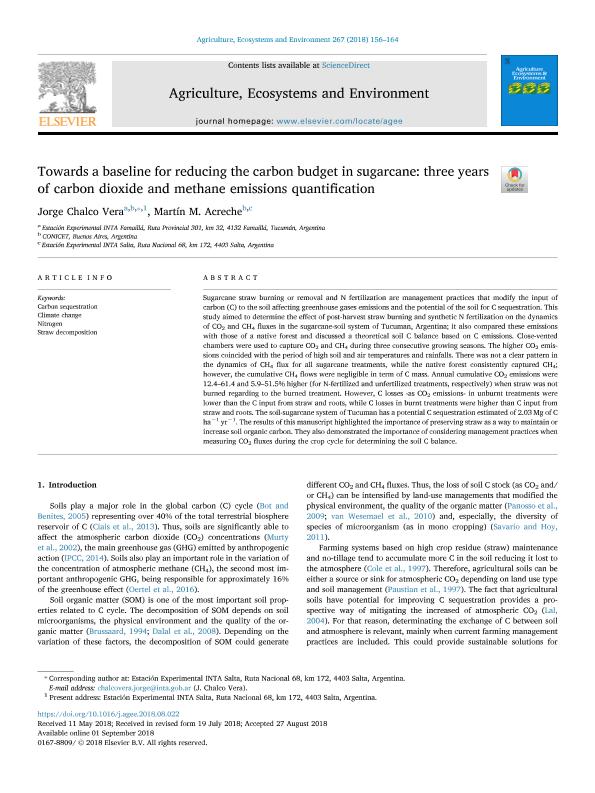Mostrar el registro sencillo del ítem
dc.contributor.author
Chalco Vera, Jorge Elías

dc.contributor.author
Acreche, Martin Moises

dc.date.available
2019-12-30T15:31:56Z
dc.date.issued
2018-11
dc.identifier.citation
Chalco Vera, Jorge Elías; Acreche, Martin Moises; Towards a baseline for reducing the carbon budget in sugarcane: three years of carbon dioxide and methane emissions quantification; Elsevier Science; Agriculture, Ecosystems and Environment; 267; 11-2018; 156-164
dc.identifier.issn
0167-8809
dc.identifier.uri
http://hdl.handle.net/11336/93219
dc.description.abstract
Sugarcane straw burning or removal and N fertilization are management practices that modify the input of carbon (C) to the soil affecting greenhouse gases emissions and the potential of the soil for C sequestration. This study aimed to determine the effect of post-harvest straw burning and synthetic N fertilization on the dynamics of CO2 and CH4 fluxes in the sugarcane-soil system of Tucuman, Argentina; it also compared these emissions with those of a native forest and discussed a theoretical soil C balance based on C emissions. Close-vented chambers were used to capture CO2 and CH4 during three consecutive growing seasons. The higher CO2 emissions coincided with the period of high soil and air temperatures and rainfalls. There was not a clear pattern in the dynamics of CH4 flux for all sugarcane treatments, while the native forest consistently captured CH4; however, the cumulative CH4 flows were negligible in term of C mass. Annual cumulative CO2 emissions were 12.4–61.4 and 5.9–51.5% higher (for N-fertilized and unfertilized treatments, respectively) when straw was not burned regarding to the burned treatment. However, C losses -as CO2 emissions- in unburnt treatments were lower than the C input from straw and roots, while C losses in burnt treatments were higher than C input from straw and roots. The soil-sugarcane system of Tucuman has a potential C sequestration estimated of 2.03 Mg of C ha−1 yr−1. The results of this manuscript highlighted the importance of preserving straw as a way to maintain or increase soil organic carbon. They also demonstrated the importance of considering management practices when measuring CO2 fluxes during the crop cycle for determining the soil C balance.
dc.format
application/pdf
dc.language.iso
eng
dc.publisher
Elsevier Science

dc.rights
info:eu-repo/semantics/openAccess
dc.rights.uri
https://creativecommons.org/licenses/by-nc-nd/2.5/ar/
dc.subject
CARBON SEQUESTRATION
dc.subject
CLIMATE CHANGE
dc.subject
NITROGEN
dc.subject
STRAW DECOMPOSITION
dc.subject.classification
Otras Ciencias Biológicas

dc.subject.classification
Ciencias Biológicas

dc.subject.classification
CIENCIAS NATURALES Y EXACTAS

dc.title
Towards a baseline for reducing the carbon budget in sugarcane: three years of carbon dioxide and methane emissions quantification
dc.type
info:eu-repo/semantics/article
dc.type
info:ar-repo/semantics/artículo
dc.type
info:eu-repo/semantics/publishedVersion
dc.date.updated
2019-10-23T21:34:15Z
dc.journal.volume
267
dc.journal.pagination
156-164
dc.journal.pais
Países Bajos

dc.journal.ciudad
Amsterdam
dc.description.fil
Fil: Chalco Vera, Jorge Elías. Instituto Nacional de Tecnología Agropecuaria. Centro Regional Tucuman-Santiago del Estero. Estación Experimental Agropecuaria Famaillá; Argentina. Consejo Nacional de Investigaciones Científicas y Técnicas; Argentina
dc.description.fil
Fil: Acreche, Martin Moises. Instituto Nacional de Tecnología Agropecuaria. Centro Regional Buenos Aires; Argentina. Consejo Nacional de Investigaciones Científicas y Técnicas; Argentina
dc.journal.title
Agriculture, Ecosystems and Environment

dc.relation.alternativeid
info:eu-repo/semantics/altIdentifier/doi/http://dx.doi.org/10.1016/j.agee.2018.08.022
dc.relation.alternativeid
info:eu-repo/semantics/altIdentifier/url/https://www.sciencedirect.com/science/article/pii/S0167880918303633
Archivos asociados
